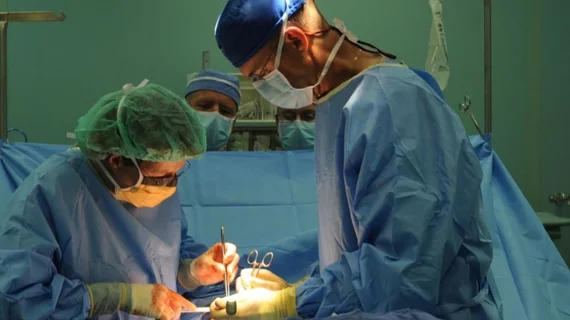Off-pump coronary artery bypass grafting (CABG) is associated with an 11 percent increased risk of mortality compared to on-pump CABG, according to a registry study of cardiac surgeries performed in New Jersey from 2005 to 2011.
Specifically, 10-year death rates with the off-pump approach were 33.4 percent, versus 29.6 percent for on-pump CABG. Researchers studied nearly 7,000 patients who underwent an off-pump procedure and more than 15,000 who had an on-pump surgery. They followed them for a median of 6.8 years but used statistical modeling to estimate the risk of various outcomes at 10 years.
“The survival effect with off-pump surgery was consistent, irrespective of whether the analysis was performed on an as-treated or intention-to-treat basis; across surgeons, irrespective of previous off-pump experience and preference; and across patient subgroups, including elderly and low ejection fraction,” reported lead author Joanna Chikwe, MD, with the Icahn School of Medicine at Mount Sinai in New York, and colleagues in the Journal of the American College of Cardiology.
In addition to the mortality benefit seen with on-pump CABG, those patients were less likely to have incomplete revascularization (8.8 percent versus 15.7 percent) and 17 percent less likely to require repeat revascularization.
The authors noted these findings were consistent with previous randomized trials and meta-analyses, but said they wanted to provide complementary data with long-term follow-up in a population more representative of routine practice.
CABG is most commonly conducted using cardiopulmonary bypass, a technique also known as on-pump surgery. However, off-pump CABG on a patient’s beating heart gained some interest for its potential to reduce complications associated with cardiopulmonary bypass and the manipulation of the aorta, the authors noted.
But this real-world analysis from New Jersey suggests the on-pump approach remains the safest, even when operators have performed hundreds of off-pump surgeries.
“The survival advantage consistently associated with on-pump over off-pump CABG has been attributed to the higher rates of incomplete revascularization, and worse graft patency with off-pump compared with on-pump CABG observed in randomized trials and retrospective studies,” Chikwe and colleagues wrote. “Patients undergoing off-pump CABG have repeatedly been shown to receive fewer bypass grafts either than planned or than the number of diseased territories, in comparison with patients undergoing on-pump CABG. … Our data confirm the higher rates of incomplete revascularization with off-pump CABG.”
In the analysis, incomplete revascularization itself was an independent predictor of late mortality—lowering the odds of patient survival by 10 percent relative to those who received complete revascularization.
“We believe that these findings have clear implications for the optimal choice of procedure in the majority of patients undergoing surgical revascularization who do not have contraindications to cardiopulmonary bypass,” the authors wrote.
The authors of an accompanying editorial agreed to some extent.
“This paper affirms prevailing evidence that, at a population level, on-pump should be the default strategy for CABG,” wrote Faisal G. Bakaeen, MD, and Vinod H. Thourani, MD.
However, the editorialists pointed out off-pump CABG can still be useful in high-risk subgroups and said the benefits of such an approach “are mostly realized in the perioperative period”—benefits that may be lost when analyzing outcomes at specific cutoffs years later.
“Off-pump CABG can improve some short-term outcomes, such as stroke, renal dysfunction, blood transfusion, respiratory failure, atrial fibrillation, wound infection, ventilation time, and length of stay,” they wrote. “The downside is that this short-term benefit can come at the long-term cost of reduced graft patency and increased risk of cardiac reintervention and death.”
Still, even as the off-pump technique is declining in North America—going from 23 percent of CABG procedures in 2002 to 17 percent in 2012—Bakaeen and Thourani believe every cardiac surgeon should be competent in the approach.
“Off-pump CABG is best performed by a few select surgeons experienced in this technique, but should be part of the armamentarium of all cardiac surgeons to optimize outcomes when faced with anatomic or physiological scenarios wherein avoiding cardiopulmonary bypass or aortic manipulation is advantageous,” they wrote.

